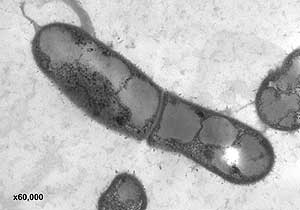Thermophilic and hyperthermophilic microorganisms are an important component of geothermal ecosystems, which include continental hot springs, solfataras, and both shallow and deep-sea hydrothermal vents. These organisms play a critical role in our understanding of several fundamental biological processes, such as microbial adaptations to elevated temperatures and prokaryotic evolution, and they represent a natural source for the discovery of thermostable enzymes.

T. ammonificans in the process of dividing. Photo courtesy
Valentin Starovoytov and Costantino Vetriani, Rutgers University
The isolation and characterization of microorganisms that are thermophilic, anaerobic, and chemolithoautotrophic (getting energy by oxidizing inorganic compounds) is critical to understand the ecology and biogeochemistry of geothermal environments. At deep-sea hydrothermal vents, these organisms fix CO2 of geothermal origin in the absence of oxygen, and therefore they represent the primary producers in these environments. The organisms that couple autotrophic CO2 fixation with nitrate respiration are of particular interest, as they link the carbon and nitrogen cycling, the latter of which has been under-studied at deep-sea vents. The recent discovery of several such novel microorganisms, including Thermovibrio ammonificans DSM 15698T, suggests that autotrophic carbon fixation coupled to nitrate respiration is a more common metabolic pathway than previously thought in geothermal environments.
Thermovibrio ammonificans DSM 15698T is an anaerobic, chemolithoautotrophic bacterium that was isolated from an active high-temperature deep-sea hydrothermal vent located at a depth of 2,500 meters. This organism grows on mineral salts in the presence of carbon dioxide and hydrogen, reducing nitrate or sulfur to ammonium or hydrogen sulfide, respectively. Analysis of the genome sequence of T. ammonificans will advance our understanding of many aspects of microbial life in geothermal environments, including carbon sequestration and alternative pathways of autotrophic CO2 fixation, proteins and gene regulatory networks, metal detoxification and bioremediation, and new mechanisms of resistance to toxic metals. The wealth of information provided by the genome sequence of a unique organism such as T. ammonificans will help to define a starting point for new insights into the multilevel organization of thermophilic organisms, their ecological role, and their evolution.
Principal Investigators: Costantino Vetriani (Rutgers Univ.)